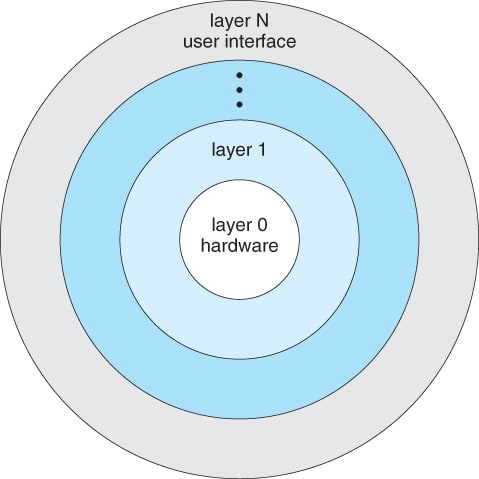
Operating System Services
• Operating systems provide an environment for execution of programs and services to programs and users
• One set of operating-system services provides functions that are helpful to the user:
• User interface - Almost all operating systems have a user interface (UI).
• Varies between Command-Line (CLI), Graphics User Interface (GUI), Batch
- Program execution - The system must be able to load a program into memory and to run that program, end execution, either normally or abnormally (indicating error)
- I/O operations - A running program may require I/O, which may involve a file or an I/O device
- File-system manipulation - The file system is of particular interest. Programs need to read and write files and directories, create and delete them, search them, list file Information, permission management.
Operating System Services (Cont.)
• Communications – Processes may exchange information, on the same computer or between computers over a network
- Communications may be via shared memory or through message passing (packets moved by the OS)
• Error detection – OS needs to be constantly aware of possible errors
- May occur in the CPU and memory hardware, in I/O devices, in user program
- For each type of error, OS should take the appropriate action to ensure correct and consistent computing
- Debugging facilities can greatly enhance the user’s and programmer’s abilities to efficiently use the system
• Another set of OS functions exists for ensuring the efficient operation of the system itself via resource sharing
- Resource allocation – When multiple users or multiple jobs running concurrently, resources must be allocated to each of them
○ Many types of resources - Some (such as CPU cycles, main memory, and file storage) may have special allocation code, others (such as I/O devices) may have general request and release code
- Accounting - To keep track of which users use how much and what kinds of computer resources
- Protection and security - The owners of information stored in a multiuser or networked computer system may want to control use of that information, concurrent processes should not interfere with each other
○ Protection involves ensuring that all access to system resources is controlled
○ Security of the system from outsiders requires user authentication, extends to defending external I/O devices from invalid access attempts
§ (If a system is to be protected and secure, precautions must be instituted throughout it. A chain is only as strong as its weakest link.)
User Operating System Interface - CLI
• Command Line Interface (CLI) or command interpreter allows direct command entry
- Sometimes implemented in kernel, sometimes by systems program
- Sometimes multiple flavors implemented – shells
○ BASH (Bourne-Again SHell), CSH (C SHell), KSH (Korn SHell), TCSH on Linux
○ CMD on windows
- Primarily fetches a command from user and executes it
○ Sometimes commands built-in, sometimes just names of programs
User Operating System Interface - GUI
• User-friendly desktop metaphor interface
- Usually mouse, keyboard, and monitor
- Icons represent files, programs, actions, etc
- Various mouse buttons over objects in the interface cause various actions (provide information, options, execute function, open directory (known as a folder)
- Invented at Xerox PARC
• Many systems now include both CLI and GUI interfaces
- Microsoft Windows is GUI with CLI “command” shell
- Apple Mac OS X as “Aqua” GUI interface with UNIX kernel underneath and shells available
- Solaris is CLI with optional GUI interfaces (GNOM, KDE)
Bourne Shell Command Interpreter
System Calls
• Programming interface to the services provided by the OS
• Typically written in a high-level language (C or C++)
• Mostly accessed by programs via a high-level Application Program Interface (API) rather than direct system call use
• Three most common APIs are
1. Win32 API for Windows
2. POSIX API for POSIX-based systems (including UNIX, Linux, and Mac OS X)
3. Java API for the Java virtual machine (JVM)
Why use APIs rather than system calls?
- To provide a simplified method of the use of system calls and hide the implementation details.
System Call Implementation
• Typically, a number associated with each system call
- System-call interface maintains a table indexed according to these numbers
- The system call interface invokes intended system call in OS kernel and returns status of the system call and any return values
• The caller need to know nothing about how the system call is implemente
- Just needs to obey API and understand what OS will do as a result call
- Most details of OS interface hidden from programmer by API
Types of System Calls
• Process control
- end, abort
- load, execute
- create process, terminate process
- get process attributes, set process attributes
- wait for time
- wait event, signal event
- allocate and free memory
• File management
- create file, delete file
- open, close file
- read, write, reposition
- get and set file attributes
• Device management
- request device, release device
- read, write, reposition
- get device attributes, set device attributes
- logically attach or detach devices
• Information maintenance
- get time or date, set time or date
- get system data, set system data
- get and set process, file, or device attributes
• Communications
- create, delete communication connection
- send, receive messages
- transfer status information
- attach and detach remote devices
Example: MS-DOS
• Single-tasking
• Shell invoked when system booted
• Simple method to run program
- No process created
• Single memory space
• Loads program into memory, overwriting all but the kernel
• Program exit -> shell reloaded
Example: FreeBSD
• Unix variant
• Multitasking
• User login -> invoke user’s choice of shell
• Shell executes fork() system call to create process
- Executes exec() to load program into process
- Shell waits for process to terminate or continues with user commands
• Process exits with code of 0 – no error or > 0 – error code
System Programs
• System programs provide a convenient environment for program development and execution. They can be divided into:
- File manipulation
- Status information
- File modification
- Programming language support
- Program loading and execution
- Communications
- Application programs
(Most users’ view of the operation system is defined by system programs, not the actual system calls)
• File management - Create, delete, copy, rename, print, dump, list, and generally manipulate files and directories
• Status information
• Some ask the system for info - date, time, amount of available memory, disk space, number of users
• Others provide detailed performance, logging, and debugging information
• Typically, these programs format and print the output to the terminal or other output devices
• Some systems implement a registry - used to store and retrieve configuration information
• File modification
- Text editors to create and modify files
- Special commands to search contents of files or perform transformations of the text
• Programming-language support - Compilers, assemblers, debuggers and interpreters sometimes provided
• Program loading and execution- Absolute loaders, relocatable loaders, linkage editors, and overlay-loaders, debugging systems for higher-level and machine language
• Communications - Provide the mechanism for creating virtual connections among processes, users, and computer systems
- Allow users to send messages to one another’s screens, browse web pages, send electronic-mail messages, log in remotely, transfer files from one machine to another
Layered Approach
• The operating system is divided into a number of layers (levels), each built on top of lower layers.
- The bottom layer (layer 0), is the hardware
- The highest (layer N) is the user interface.
• With modularity, layers are selected such that each uses functions (operations) and services of only lower- level layers
- A typical OS layer (layer M) consists of data structure and a set of routines that can be invoked by higher-level layers.
- Layer M, in tern, can invoke operations on lower-level layers.

